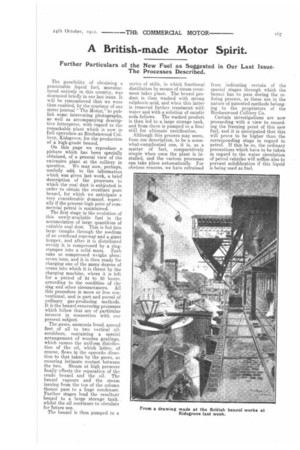A British-made Motor Spirit.
Page 13

If you've noticed an error in this article please click here to report it so we can fix it.
Further Particulars of the New Fuel as Suggested in Our Last Issue. The Processes Described.
The possibility of obtaining a practicable liquid fuel, ma.n utac tu red entirely in this country, was discussed briefly in our last issue. It will be remembered that we were then enabled, by the courtesy of our sister journal " The Motor," to publish some interesting photographs, as well as accompanying descriptive letterpress, with regard to the remarkable plant which is now in full operation at Birchenwood Colliery, Kidsgrove, for the production of a high-grade benzol. On this page we reproduce a picture which has been specially obtained, of a general view of the extensive plant at the colliery in question. We may now, perhaps, usefully add, to the information which was given last week, a brief description of the processes to which the coal dust is subjected in order to obtain the resultant pure benzol, for which we anticipate a very considerable demand, especially if the present high price of commercial petrol is maintained.
The first stage in the evolution of this newly-available fuel is the accumulation of large quantities of suitable coal dust. This is fed into large troughs through the medium of an overhead ropeway and a giant hopper, and after it is distributed evenly it is compressed by a slagstamper into a solid mass. Each cake so compressed weighs allow: seven tons, and it is then ready for charging one of the many dozens of ovens into which it is thrust by the charging machine, where it is left for a period of 24 to 30 hours, according to the condition of the slag and other circumstances. All this procedure is more or less conventional, and is part and parcel of ordinary gas-producing methods.
• It is the benzol-recovering processes which follow that are of particular interest in connection with our present subject. The gases, ammonia freed, ascend first of all to two vertical oilscrubbers, containing a special arrangement of wooden gratings, which ensure the uniform distribution of the oil, which latter, of course, flows in the opposite direction to that taken by the gases, so ensuring intimate contact between the two. Steam at high pressure finally effects the separation of the crude benzol and the oil. The benzol vapours and the steam issuing from the top of the column thence pass to a huge condenser. Further stages lead the resultant benzol to a large storage tank, whilst the oil continues to circulate for future use.
The benzol is then pumped to a
series of stills, in which fractional distillation by means of steam treatment takes place. The benzol product is then washed with strong sulphuric acid, and when this latter is removed further treatment with water and with a solution of caustic soda follows. The washed product is then led to a large storage tank. and from there is pumped to a final still for ultimate rectification.
Although this process may seem, from our description, to be a somewhat-complicated one, it is, as a matter of fact, comparatively simple when once the plant is installed, and the various processes can take place automatically. For obvious reasons, we have refrained
from indicating certain of the special stages through which the benzol has to pass during the refining process, as these are in the nature of patented methods belonging to the proprietors of the Birchenwood Colliery Co.
Certain investigations are now proceeding with a view to recording the freezing point of this new fuel, and it is anticipated that this will prove to be higher than the corresponding stage in regard to petrol. If this be so, the ordinary precautions which have to be taken in regard to the water circulation of petrol vehicles will suffice also to prevent solidification if this liquid is being used as fuel.






















